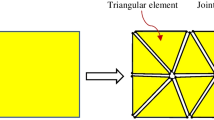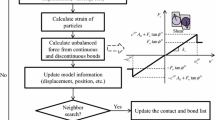Abstract
Toppling is a representative failure mode of discontinuity-controlled rock slopes. As a discrete numerical method, discontinuous deformation analysis (DDA) is well-suited for simulating the movement process, contact transformation, and large displacement and deformation of rock block systems, which are formed in jointed rock masses. In the present study, a three-dimensional (3D) DDA method was conducted to study the toppling failure mechanisms of rock slopes by introducing the global contact theory. Considering dynamic equilibrium conditions, the analyses of toppling slopes were performed and the corresponding formulations were derived. The algebraic and mechanical computation of the global contact theory was illustrated and implemented into the 3D DDA method. An experimental apparatus for studying the toppling process of blocks was developed and a series of laboratory experiments were carried out for different block distributions under different conditions. By comparing with the results of the analytical methods and laboratory experiments, the accuracy of the 3D DDA method was verified. Numerical examples, including a classical toppling slope, an ideal mountain slope, and a real toppling case were analyzed to further research the toppling failure mechanisms. The results revealed that the 3D DDA method can effectively predict slope instability and simulate the failure process of toppling slopes. The results of the dynamics-based formulations, experiments and 3D DDA enrich the instability conditions of slope-toppling. Moreover, the general phenomena and laws of the toppling failure were presented.
















Similar content being viewed by others

References
Aydan Ö, Shimizu Y, Ichikawa Y (1989) The effective failure modes and stability of slopes in rock mass with two discontinuity sets. Rock Mech Rock Eng 22(3):163–188
Bakun-Mazor D, Hatzor YH, Glaser SD (2012) Dynamic sliding of tetrahedral wedge: the role of interface friction. Int J Nume Anal Meth Geomech 36(3):327–343
Bao HR, Zhao ZY (2012) The vertex-to-vertex contact analysis in the two-dimensional discontinuous deformation analysis. Adv Eng Softw 45(1):1–10
Beyabanaki SAR, Mikola RG, Biabanaki SOR, Mohammadi S (2009) New point-to-face contact algorithm for 3-D contact problems using the augmented Lagrangian method in 3-D DDA. Geomech Geoeng Int J 4(3):221–236
Bray JW, Goodman RE (1981) The theory of base friction models. Int J Rock Mech Min Sci 18(6):453–468
Chen GQ, Ohnishi Y, Ito T (1998) Development of high-order manifold method. Int J Numer Methods Eng 43(4):685–712
Chen GQ, Zheng L, Zhang YB, Wu J (2013) Numerical simulation in rockfall analysis: a close comparison of 2-D and 3-D DDA. Rock Mech Rock Eng 46(3):527–541
Chen ZY, Gong WJ, Ma GW, Wang J, He L, Xing YC, Xing JY (2015) Comparisons between centrifuge and numerical modeling results for slope toppling failure. Sci China Technol Sci 58(9):1497–1508
Cundall PA (1971) A computer model for simulating progressive, large scale movements in blocky rock systems. Proc Int Symp Rock Fract Nancy, France, pp 129–136
Doolin DM, Sitar N (2004) Time integration in discontinuous deformation analysis. J Eng Mech 130(3):249–258
Goodman RE, Bray JW (1976) Toppling of rock slopes. In: Proceedings of the specialty conference on rock engineering for foundations and slopes. American Society of Civil Engineers, Boulder, pp 201–234
Goodman RE, Shi GH (1985) Block theory and its application to rock engineering. Prentice-Hall Inc, New Jersey
Grayeli R, Mortazavi A (2006) Discontinuous deformation analysis with second-order finite element meshed block. Int J Numer Anal Meth Geomech 30(15):1545–1561
Hatzor YH, Arzi AA, Zaslavsky Y, Shapira A (2004) Dynamic stability analysis of jointed rock slopes using the DDA method: King Herod’s Palace, Masada, Israel. Int J Rock Mech Min Sci 41(5):813–832
Hoek E, Bray JW (1977) Rock slope engineering, 1st edn. The Institution of Mining and Metallurgy, London
Hu YD (2015) The toppling deformation rock characteristics and reinforcement measures of research in the front of the dam of Miaowei hydropower station. Dissertation, Chengdu University of Technology
Jiang QH, Yeung MR (2004) A model of point-to-face contact for three-dimensional discontinuous deformation analysis. Rock Mech Rock Eng 37(2):95–116
Keneti AR, Jafari A, Wu JH (2008) A new algorithm to identify contact patterns between convex blocks for three-dimensional discontinuous deformation analysis. Comput Geotech 35(5):746–759
Liu J, Kong X, Lin G (2004) Formulation of the three-dimensional discontinuous deformation analysis method. Acta Mech Sin 20(3):270–282
Liu CH, Jaksa MB, Meyers AG (2009) A transfer coefficient method for rock slope toppling. Can Geotech J 46(1):1–9
Ning Y, Zhao Z (2013) A detailed investigation of block dynamic sliding by the discontinuous deformation analysis. Int J Numer Anal Meth Geomech 37(15):2373–2393
Pritchard MA, Savigny KW (1990) Numerical modeling of toppling. Can Geotech J 27:823–834
Sagaseta C (1986) On the modes of instability of a rigid block. Rock Mech Rock Eng 19(4):261–266
Shi GH (1988) Discontinuous deformation analysis: a new numerical model for the statics and dynamics of block systems. Dissertation, University of California, Berkeley
Shi GH (2001) Three-dimensional discontinuous deformation analysis. In: Proceedings of the 4th international conference on analysis of discontinuous deformation. Scotland, pp 1–21
Shi GH (2015) Contact theory. Sci China Technol Sci 58(9):1–47
Tang CA, Tang SB, Gong B, Bai HM (2015) Discontinuous deformation and displacement analysis: from continuous to discontinuous. Sci China Technol Sci 58(9):1567–1574
Wu JH (2008) New edge-to-edge contact calculating algorithm in three-dimensional discrete numerical analysis. Adv Eng Softw 39(1):15–24
Wu JH (2010) Seismic landslide simulations in discontinuous deformation analysis. Comput Geotech 37(5):594–601
Wu JH, Ohnishi Y, Nishiyama S (2004) Simulation of the mechanical behavior of inclined jointed rock masses during tunnel construction using Discontinuous Deformation Analysis (DDA). Int J Rock Mech Min Sci 41(5):731–743
Wu JH, Ohnishi Y, Shi GH, Nishiyama S (2005) Theory of three-dimensional discontinuous deformation analysis and its application to a slope toppling at Amatoribashi, Japan. Int J Geomech 5(3):179–195
Yagoda-Biran G, Hatzor YH (2016) Benchmarking the numerical discontinuous deformation analysis method. Comput Geotech 71:30–46
Yeung MR, Jiang QH, Sun N (2007) A model of edge-to-edge contact for three dimensional discontinuous deformation analysis. Comput Geotech 34(3):175–186
Zanbak C (1983) Design charts for rock slopes susceptible to toppling. J Geotech Eng ASCE 109(8):1039–1062
Zhang GX, Zhao Y, Peng XC (2010) Simulation of toppling failure of rock slope by numerical manifold method. Int Comput Method 7:167–189
Zhang YB, Xu Q, Chen GQ, Zhao JX, Zheng L (2014) Extension of discontinuous deformation analysis and application in cohesive-frictional slope analysis. Int J Rock Mech Min Sci 70:533–545
Zhang Z, Wang T, Wu S, Tang H (2015) Rock toppling failure mode influenced by local response to earthquakes. Bull Eng Geol Env 75(4):1361–1375
Zhang H, Liu SG, Zheng L, Zhong GH, Lou S, Han Z (2016) Extensions of edge-to-edge contact model in three-dimensional discontinuous deformation analysis for friction analysis. Comput Geotech 71:261–275
Zhang H, Liu SG, Wang W, Zheng L, Zhang YB, Wu YQ, Han Z, Li YG, Chen GQ (2018) A new DDA model for kinematic analyses of rockslides on complex 3-D terrain. Bull Eng Geol Environ 77:555–571
Acknowledgements
This research was supported by the National Key Research and Development Program of China under Grant Nos. 2016YFC0401600 and 2017YFC0404906, the National Natural Science Foundation of China under Grant Nos. 51769033 and 51779035, and the Fundamental Research Funds for the Central Universities under Grant No. DUT17ZD205.
Author information
Authors and Affiliations
Corresponding author
Additional information
Publisher's Note
Springer Nature remains neutral with regard to jurisdictional claims in published maps and institutional affiliations.
Rights and permissions
About this article
Cite this article
Liu, G., Li, J. & Kang, F. Failure Mechanisms of Toppling Rock Slopes Using a Three-Dimensional Discontinuous Deformation Analysis Method. Rock Mech Rock Eng 52, 3825–3848 (2019). https://doi.org/10.1007/s00603-019-01797-6
Received:
Accepted:
Published:
Issue Date:
DOI: https://doi.org/10.1007/s00603-019-01797-6



